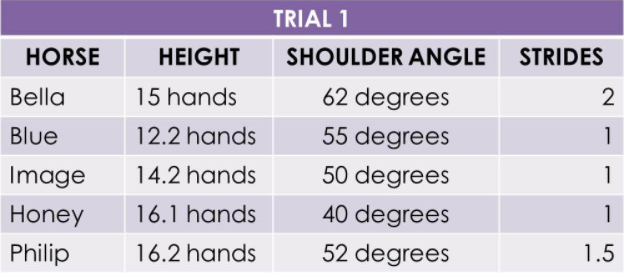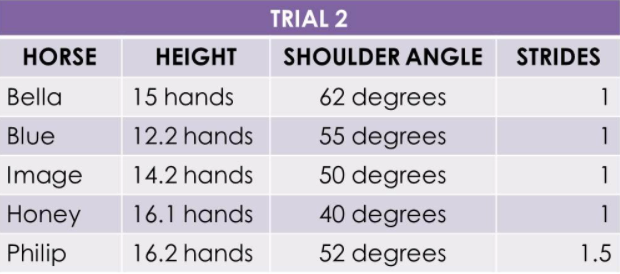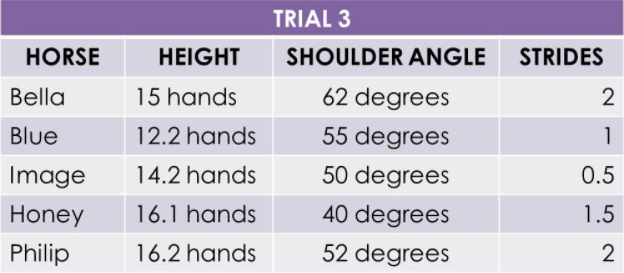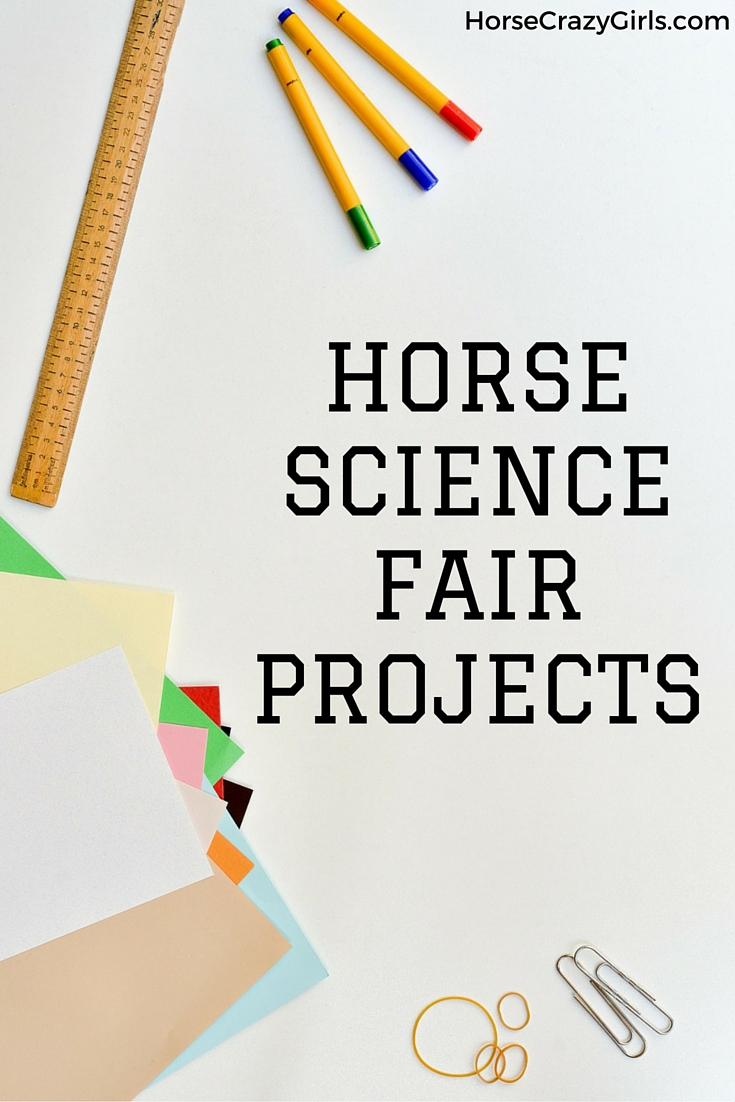Horse Science Fair Projects
Read Other Horse Science Fair Projects
“Click below to read other students’ horse science fair projects. You might find an idea you can build on!”
We would love to hear about any Horse Science Fair Project you did or any ideas you have! 




Leave a comment telling us all about the project or idea you have! Things like what question were you trying to answer, what did you do, and what did you …
- Components of horse science fair projects
- Horse Science Fair Project Ideas
- Tips for Science Fair Projects With Horses
- Resources and references for a horse science fair project
Components of horse science fair projects
I don’t know about you, but the idea of having to do science fair projects every year for 4th grade, 5th grade, 6th grade, 7th grade, and 8th grade was unappealing. But once I realized I could do all of my science fair projects with horses, the idea of doing science fair projects every year became much more appealing. However, when I tried to look up horse science fair projects online for inspiration I could not find much.
So, I decided to start a page dedicated to horse science fair projects. Here you can find different horse science fair project ideas for different grade levels, along with actual science fair experiments for different grade levels, that tell you what you need for the experiments and how to do the science fair projects.
But before looking at different horse science fair project ideas and different horse science fair experiments, it is important to know exactly what the different components make up a good science fair project.This page may contain affiliate links which may earn a commission.
First: Hypothesis
You need to have a well thought out hypothesis for your science fair project. A hypothesis is a well thought out question that you aim to answer through your experiment. In order to construct a good hypothesis you will want to write down different questions you currently have regarding horses or something related to horses. Then you will want to start doing some research into each question to see what information about your question is out there. Finally you can construct your hypothesis from your research. Every good science fair project starts with a good hypothesis.
For example: Let’s say my list of questions was
Does shoulder angle affect stride length?
Do horses’ eyes change color as they age?
Are horses more or less spooky when in a herd?
Well from this list of different horse related questions I could go to the internet and start researching them to see what is out there but before I do even that I can quickly pair down my list. I can immediately cross off the second question because I only have a few months to do this experiment and to look at horses’ eyes as they age would take years. So now that I am down to two questions I can go to the internet and see what is out there and choose which question intrigues me more and that I think I could successfully test. Hypothetically, let’s say I found a scientific paper saying horses with smaller shoulder angles have longer strides. I could use that paper for the basis of my hypothesis which would be “If the horse or pony has a smaller shoulder angle, then the horse or pony will have a longer stride”.
Second: Methods
Now that a hypothesis has been established you can create your methods for your science fair project. The methods section should include the exact procedure you will use for your experiment. You will want this section to be very detailed. The idea is that anyone should be able to replicate your science fair project from your methods section.
For example:
- First, have the horse or pony stand square; measure the horse or pony’s height.
- Then, take a picture of the horse or pony; print the picture out.
- From the picture you will then draw a line (with the marker) to the point of shoulder.
- After drawing a line to the point of shoulder draw a line (with the marker) across the horse’s or pony’s body.
- Once these two lines have been drawn measure the horses shoulder angle with the protractor.
- After measuring out 12’ to 6’ distance (depending on if it is a horse or pony) place a pole at the beginning of the distance and at the end, out of the horse’s or pony’s path.
- Have the horse or pony canter the given distance (with the rider on them) while counting the strides they take over the given distance (it should only be one stride).
- Lastly, record the results.
Third: Controls, Variables, and Materials
Once you have your methods you will want to list the controls, variables, and materials for the science fair project. Controls in an experiment refer to the things that we keep the same so that the science fair project is as exact as possible. Variables in an experiment are broken into two categories; independent variables and dependent variables. Independent variables are those that you change while dependent variables are those that change in response to what you have changed.
For example: The controls of this science fair experiment are the distance measured, the poles, the rider, the tack, the protractor, the way the horse’s or pony’s shoulder angle is measured, the place, the camera and printer. The dependent variables of this experiment include the horse’s or pony’s stride. The independent variables of this experiment include the time of day, the day, the weather, the horse's attitude, the horses or ponies, horses or ponies shoulder angle, and the horse’s or pony’s height.
Fourth: The experiment
Now that you have everything prepared and a plan in place you can perform the actual science fair project. This is done simply by doing what you said you were going to do in the methods section. The science experiment may not go as you planned or you may have to slightly change your methods if you notice a consistent problem with the experiment. Typically, you will want to do at least three trials so you can get more accurate results.
Fifth: Data and Results
Once the science experiment is done you can compile all of your data. You should have all the data for each trial (usually in table format). In addition to the tables you will also most likely want to construct graphs and/or charts that relate to your data. On top of the data you will need to write a small section on what your data showed in reference to your hypothesis. The written section is what is known as the results.
For example:
Trial one agreed with the hypothesis. The horses and ponies in trial one reached the correct number of strides for the horse or pony’s shoulder angle.
Trial two mostly agreed with the hypothesis. The horses and ponies in trial two reached the correct number of strides for the horse or pony’s shoulder angle.
Trial three didn't agree with the hypothesis. Three of the horses and ponies were not in the stride length range for the horse or pony’s shoulder angle.
Overall, the hypothesis was supported by the trials.
Sixth: Conclusion
The conclusion is meant to summarize your science fair project in a paragraph or two. The most important part of this section is to talk about whether the hypothesis was supported or not supported and why. Unlike the results section it doesn’t need to dive deep into the data but rather just tell the reader the overall takeaway.
For example: In conclusion, the hypothesis that was created was agreed with. Both trial one and two agreed with the hypothesis while trial three disagreed with the hypothesis. The experiment showed that height has nothing to do with a horse or pony's shoulder angle. Instead, it showed that the larger the horse or pony's shoulder angle, the shorter the stride length. The three trials did prove the hypothesis.
Seventh: Recommendations
Once the science fair experiment is over and you have collected your results you will need to write a recommendations section. The recommendations section basically describes what variables could have influenced the science fair experiment and how you would improve the science fair experiment going forward.
For example: Variables that might have affected the experiment were the weight of the rider, the tack used, the day, the time, the tiredness of the horse or pony, the weather, the ability of the rider, the health of the horse or pony, the number of trips, the position of the rider, and the height of the rider. These variables could have impacted the outcome of the experiment. For future improvement, I could use more horses and ponies, use a rider of a different weight, height, or experience. I could also pick a cooler day or maybe also just do one trial a day.
Eighth: Abstract
The abstract is another important component of any science fair experiment. The abstract often goes over the purpose of the experiment, the trials you conducted, results, controls, and variables. Basically, it gives a brief overview of your entire science fair project from beginning to end.
For example: The purpose of this experiment is to find out if the horse’s shoulder angle or the horse’s height affects its stride. The subjects of the experiment are three horses and two ponies. If the subject has a smaller shoulder angle, then the subject will have a longer stride.
Trial one agreed with the hypothesis. The subjects in trial one reached the correct number of strides for the subject’s shoulder angle. Trial two mostly agreed with the hypothesis.
The subjects in trial two reached the correct number of strides for the subject’s shoulder angle.
Trial three didn't agree with the hypothesis. For the third trial, three of the subjects were not in the stride length range for the subject’s shoulder angle.
Overall, the hypothesis was supported. In conclusion, the hypothesis was agreed with.
The first two trials agreed with the hypothesis. Trial three disagreed with the hypothesis.
The experiment showed that height has nothing to do with a subject's shoulder angle. Instead, it showed that the larger the subject's shoulder angle, the shorter the stride length.
The controls of this experiment are the distance measured, the poles, the rider, the tack, the protractor, the way the subject's shoulder angle is measured, the location, and the camera and printer.
The dependent variables of this experiment include the subject’s stride. The independent variables of this experiment include the time of day, the day, the weather, the subject’s attitude, the subject’s shoulder angle, and the subject’s height.
Ninth: Purpose, Problem, and Application
In your science fair project you will also most likely need to include the purpose of your experiment, the problem you are addressing in your experiment, and how your experiment can be helpful in the real world.
For example: The purpose of this experiment is to find out if the horse’s shoulder angle or the horse’s height affects its stride. The problem in this experiment is, does the shoulder angle or height of the horse affect its stride? The application of this experiment is that it could be proven useful for people who are buying, selling, riding, jumping a horse or pony. It could even be helpful to people trying to figure out the horse’s or pony’s estimated stride length.
If you just want to see the example experiment I gave without the explanation on what everything is, head to the Horse Science Fair Experiment page.
Tip: Be ready to talk about your project! Every grader I had during my science fair years would ask me several follow up questions. It is a great idea to not only practice presenting your project, but to also have those who watched ask you some practice questions.
Horse Science Fair Project Ideas
I asked all my horse crazy friends for ideas for horse science fair projects and here's what they shared.I think that the large majority of these projects would be fine for anyone in 4th, 5th grade, 6th grade, 7th grade, or 8th grade. The nice part about any of these ideas is that you can make it more or less challenging based on your grade level.
Some of these science fair ideas involving horses are not quite ready to go in their current format, but that's okay hopefully they can provide you inspiration.
Horse Anatomy
by Anonymous
You can do a project on a horse's insides and bones - how they work.
How Much Dirt a Hoof Collects
by Kaley
I did this at my science fair. It is about determining which hooves - front or back, collect the most dirt or mud. You clean the hooves, but put the mud in a sandwich bag and measure it. I hope this helps.
Enlightened Equitation!
by Lucinda, Godalming Surrey England
This project is about how the horse moves - different gaits of a horse and how they vary within the different horse breeds, such as the Fox Trot, Tennessee walking, Cob, Icelandic, Thoroughbred, etc.
It's also about how the horses conformation affects the way it moves (static and dynamic). Other horse breeds could include Lipizzaner, Andalusian, American Saddlebred, Standardbred, Arabian, etc.
Which Breed is Faster or Prettiest?
by Jem, Crownsville MD
You could do an experiment and ask owners of different horse breeds (you don't have to do all of them you can just do a few) and see them run and see their speed with a radar gun or you can do kind of the same thing except you see which breed is the prettiest.
Which Treats do Horses Respond to Best?
by Ava, Albany NY USA
My friend Chloe did this experiment one year at her stable with a couple different horses. She wanted to see which horse treats would the horses be more eager to work for. I thought it was a good idea for a project because it could help the owner find which treats to buy and what not to buy. Hope you like it!
Which Grain is Better for Horses?
by Savannah, Utah
Looking for horse science fair projects? Maybe what you could do, is you could take two horses and take two types of grain. The one you use now, and a different brand. Then see what grain makes what horse feel better and stuff. I just learned about this in science and thought it would be cool
Comparing Horse Behavior to Human Behavior
by Hannah
You could compare the behavior of horses and humans. Observe the rankings in a herd and observe a group of friends and their ranks. For example, "Who's the herd/group leader? Who's his/her right hand man? Who's the one no one likes?" Look for things like that.
What Types of Hay Do Horses Prefer?
by Alison, Boston Massachusetts USA
You could use different types of hay and see what your horses like better.
Which Horse Products do Horses Most React To?
by Evangeline, Alaska
You could take a little sample of hoof polish, stain sprays, anything that is advertised as THE BEST and see how it reacts to three types of liquid such as water, vinegar and soda pop.
Horse Videos
by Rebecca, VA
You could definitely take a video about your horse and then show it or pics about the part of the body or you could talk about the evolution of a horse (with lots of color... everyone loves color!) Hope this helps!
An Electrically-Charged Horse
by Alexis
I would make a horse made out of clay and put the body parts together, but before I put it together I would put electrical charges through the hollow clay.
Science Project Idea by Anonymous This animal science/equine science project would be easy for a horse lover to do during the school year, because you don't need a horse. You could just take different saddle pads made out of different material and measure how much heat they trap vs. let through.
Magical Horse
by Jaden, Maryland USA
You can buy horse paint which is perfectly safe for horses and make the legs look like zebra and the body purple also the tail and hair will be rainbow colors and add horse wings. Then you have your magical horses.
Guess the Part of the Horse
by Georgina, England
A part of the horses body/organs is shown (picture) then you have to name what it is and then place it on a large horse picture where you think it must go. If both are correct you win!
Horses’ Senses
by Stephanie, Quebec Canada
This horse science fair project is all about the horses’ senses - what they have and how it helps them.
The Horse’s Body
by Mattie, Auburn AL
You could create a model of a horses body. where their bones are, how it works, and where the organs are. I think it would fun! You could ask a vet to help if you needed it.
Heart Rate by Anonymous A middle school or high school student could measure how horse's heart rates respond to different stimuli. Another option would be to measure how different calming techniques affect horse's heart rate or you could see how different human emotions affect horse's heart rate.
If you’ve done a project like this or have an idea for a horse science fair project, please share.
Tips for Science Fair Projects With Horses
Here are important tips when making science fair projects with horses.- You will need to find out if your school will allow you to conduct your science fair project with animals. If your school gives you permission to use horses in your horse science fair project you will need to find a horse or horses to use. So, you will probably need to ask around to find out if you can use other people's horses, or whether they must be your own (if you don't have a horse or horses.)
- Make sure you can repeat your science fair experiment. Often you must do the same procedure at least three times.
- Be sure you have time to complete your science fair experiment. Unexpected issues such as bad weather, a horse getting sick, a horse going to a horse show for a week, etc could all lead to you not having the necessary time to do your science fair project.
- It is also important to remember to be safe! A horse can be unpredictable especially if they feel scared and stressed. Remember to always treat your horse with respect and love.
Resources and references for a horse science fair project
The following are some resources and references you can use for a horse science fair project:Science Fair Printable Planner Pages: These planner pages really help if you struggle with staying focused and organized or just need help understanding the steps in a science fair project. I wish I had this planner for my first middle school science fair project.
Help On How To Lay Out Your Poster Board: This website gives some great tips for how to lay out your poster board for your science fair project and how they are often judged.
Easy And Free Graph Maker: This service is completely free and super easy to use. You can choose from all the major chart and graph choices, you can enter lots of data, and you can customize the colors of your graph.
More Science Fair Experiments And Projects: This website is great because it lets you filter by grade level, cost, time, and more.








